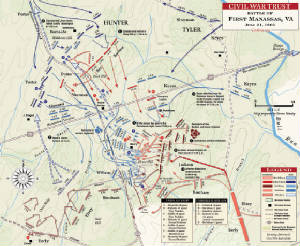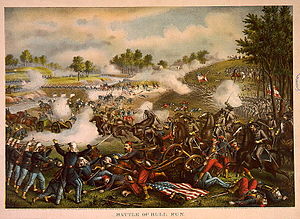|
| 1st Battle of Manassas Map |

|
| Civil War First Battle of Manassas Map |
Cheers rang through the streets
of Washington
on July 16, 1861, as Gen. Irvin McDowell's army, 35,000 strong, marched out to begin the long-awaited campaign to capture
Richmond and end the war. It was an army of green recruits,
few of whom had the faintest idea of the magnitude of the task facing them. But their swaggering gait showed that none doubted
the outcome. As excitement spread, many citizens and congressmen with wine and picnic baskets followed the army into the field
to watch what all expected would be a colorful show. These troops were mostly 90-day volunteers summoned by President Abraham
Lincoln after the startling news of Fort Sumter
burst over the nation in April 1861. Called from shops and farms, they had little knowledge of what war would mean.
On a warm July day in 1861,
two armies of a divided nation clashed for the first time on the fields overlooking Bull Run.
Their ranks were filled with enthusiastic
young volunteers in colorful new uniforms, gathered together from every part of the country. Confident that their foes would
run at the first shot, the raw recruits were thankful that they would not miss the only battle of what surely would be a short
war. But any thought of colorful pageantry was suddenly lost in the smoke, din, dirt, and death of battle. Soldiers on both
sides were stunned by the violence and destruction they encountered. At day's end nearly 900 young men lay lifeless on the
fields of Matthews Hill, Henry Hill, and Chinn Ridge. Ten hours of heavy fighting swept away any notion the war's outcome
would be decided quickly (see: Battle of First Manassas: A Major Turning Point?).
First Manassas: The Campaign
The first day's march covered only five miles, as many straggled
to pick blackberries or fill canteens.
General McDowell's lumbering columns were headed for the vital railroad junction at Manassas. Here the Orange and Alexandria Railroad met the
Manassas Gap Railroad, which led west to the Shenandoah Valley. If McDowell could seize this junction, he would stand astride the best overland approach to the Confederate capital. On
July 18, McDowell's army reached Centreville. Five miles ahead a small meandering stream named Bull Run crossed the route
of the Union advance, and there guarding the fords from Union Mills to the Stone Bridge waited 22,000 Southern troops under
the command of General Pierre G. T. Beauregard. McDowell first attempted to move toward the Confederate right flank, but his troops were checked at Blackburn's Ford near
the center of Beauregard's defensive line. He then spent the next two days scouting the Southern left flank. In the meantime,
Beauregard asked the Confederate government at Richmond for help. General Joseph E. Johnston, stationed in the Shenandoah Valley with 10,000 troops, was ordered to support Beauregard if possible. Johnston gave an opposing
Union force the slip and, employing the Manassas Gap Railroad, started his brigades toward Manassas Junction. Most of Johnston's
troops arrived at the junction on July 20 and 21, some marching from the trains directly into battle.
First Manassas: Morning, July 21, 1861
On the morning of July 21, McDowell sent his attack columns in
a long march north toward Sudley Springs Ford. This route took the Federals around the Confederate left. To distract the Southerners,
McDowell ordered a diversionary attack where the Warrenton Turnpike crossed Bull Run at the Stone Bridge. At 5:30 a.m. the
deep-throated roar of a 30-pounder Parrott rifle shattered the morning calm, and signaled the start of battle.
McDowell's
new plan depended on speed and surprise, both difficult with inexperienced troops. Valuable time was lost as the men stumbled
through the darkness along narrow roads. Confederate Col. Nathan Evans, commanding at the Stone Bridge, soon realized that
the attack on his front was only a diversion. Leaving a small force to hold the bridge, Evans rushed the remainder of his
command to Matthews Hill in time to check McDowell's lead unit. But Evans' force was too small to hold back the Federals for
long.
Soon brigades under Barnard Bee and Francis Bartow marched to Evans' assistance. But even with these reinforcements,
the thin gray line collapsed and Southerners fled in disorder toward Henry Hill. Attempting to rally his men, Bee used Gen. Thomas J. Jackson's newly arrived brigade as an anchor. Pointing to Jackson, Bee shouted, "There stands Jackson like a stone wall! Rally
behind the Virginians!" Generals Johnston and Beauregard then arrived on Henry Hill, where they assisted in rallying
shattered brigades and redeploying fresh units that were marching to the point of danger.
First Manassas: Afternoon, July 21, 1861
About noon, the Federals stopped their advance to reorganize for
a new attack. The lull lasted for about an hour, giving the Confederates enough time to reform their lines. Then the fighting
resumed, each side trying to force the other off Henry Hill. The battle continued until just after 4 p.m., when fresh Southern
units crashed into the Union right flank on Chinn Ridge, causing McDowell's tired and discouraged soldiers to withdraw.
At
first the withdrawal was orderly. Screened by the regulars, the three-month volunteers retired across Bull Run, where they
found the road to Washington jammed with the carriages of congressmen and others who had driven out to Centreville to watch
the fight. Panic now seized many of the soldiers and the retreat became a rout. The Confederates, though bolstered by the
arrival of President Jefferson Davis on the field just at the battle was ending, were too disorganized to follow up their
success. Daybreak on July 22 found the defeated Union army back behind the bristling defenses of Washington.
| 1st Battle of Manassas Campaign |

|
| First Battle of Manassas Civil War History |
Source: Manassas
National Battlefield Park
|

